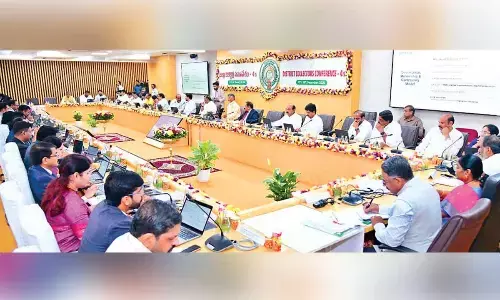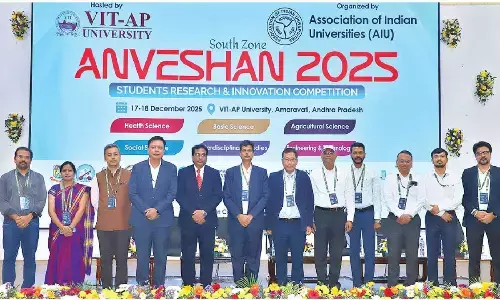Changing the fabric of textile industry through technology

From the mulberry and cotton farms to the retail stores stacked with endless rows of glittering sarees, stakeholders throughout the natural fibre supply chain aspire to be self-sufficient, besides wanting to guard against the uncertainties of the market. Adoption of digital solutions, across the board, can ensure that the stakeholders, particularly those at the grassroots – farmers, reelers, and weavers – are deservingly rewarded.
Meanwhile, the retailer, equipped with knowledge of the entire lifecycle of both the raw materials and the fabric, can leverage their superior quality to set the price with greater precision. Enhanced quality, coupled with a boost in overall productivity, has ensured a manifold increase in the income of every stakeholder that is part of the natural fibre value chain. In the recent past, many villages have had farmers, reelers, and weavers, scripting such success stories with the assistance of technology, coupled with an enabling ecosystem. Digital solutions have enabled stakeholders in the largely rural textile sector to supplement the benefits they have accrued from improved internet connectivity and smartphone penetration.
Assurance of quality
To give an example, the weaving of silk is a highly complex task. Silk cocoons harvested from mulberry leaves need to be transported from the farms within a stipulated period of time since each minute lost in transit can affect the quality of yarns. Mulberry farmers often complain of the ordeal they have to endure in transporting silk cocoons – these include having to rise at odd hours, securing transport, and arranging for compact storage spaces.
Digital integration of the entire ecosystem on an app, for instance, would enable farmers to almost immediately transport the harvested cocoons to the reelers /yarn manufacturers. Immediately after harvesting the cocoons, once the farmer sends an alert on this app, he can leave the task of transporting them to able logistics handlers. Meanwhile, with third-party vendors ensuring the transport of cocoons in sterile chambers, neither the reeler nor the farmer needs to worry over the probable deterioration of the cocoons and can rest assured of being fairly remunerated. Streamlining the supply chain, right from the farm to the retail outlet, will usher in consistency in pricing, while data availability on both domestic and global markets will help sustain perennial demand.
Scope for experimentation
Today, leveraging the immense scope of 3D printing, and computer-aided design technologies, weavers can be more adventurous in the design of garments. Increased employment of 3D printing can result in a proportionate reduction in the utilisation of natural resources such as water. Furthermore, as the industrial world prepares to embrace the full-fledged capabilities of ‘Industry 4.0’, the use of 3D printers at a textile mill ensures that the transition of the traditional handloom mill into a ‘Smart’ manufacturing plant is seamless.
Towards sustainability
Shrinking arable land, depleting natural resources, and rising pollution levels, are among the problems expected to effect a marked reduction in the overall output of the natural fibre sector across the world. Cognisant of these challenges, stakeholders in the sector are proactively seeking sustainable alternatives to cotton and silk.
Leveraging an extensive suite of advanced digital solutions, the industry is now experimenting with banana peel, and pineapple leaf, to meet the twin objective of meeting growing demand, while keeping the industry’s overall carbon footprint to a bare minimum. Notwithstanding the untapped potential of the man-made fibre market in the country, the natural fibre ecosystem remains the bedrock of India’s textile and apparel industry. It is the abundant availability of raw materials – India is the largest producer of cotton and the second largest producer of silk – that is driving sustained investment in the sector(1).
Nurturing the supply of natural fibres to what is an expanding sector amid the harsh realities of climate change is a challenge that technology-powered sustainable solutions can help surmount.
Ready financial assistance at the fingertip
Farmers engaged in the cultivation of mulberry, cotton, or other natural fibres, often struggle with a wide range of problems, ranging from difficulties in securing financial assistance, and quality raw materials, to poor logistics infrastructure, and inconsistent pricing. Although the GoI has rolled out plenty of schemes aimed at easing access to finance for these farmers, a lack of awareness about these initiatives prompts them to turn to the more traditional financial institutions. But banks and NBFCs often fail to factor in the constraints under which these farmers toil – problems range from the long cash conversion cycle to the equally short lifespan of the raw produce.
Consequently, farmers either find the terms offered on loans unattractive or secure limited funds that severely curtail the scope of their operations. However, fintech firms, through the use of credit scores, big data tools, and a more transparent operational framework, are endeavouring to lend a much-needed hand to farmers(2). Farmers cultivating mulberry on a patch of land as small as half an acre can now apply for loans on their smartphones, owing to the digitisation of the financial process. The transparency that the digitised financial ecosystem guarantees has also simplified the process for claiming insurance, with stakeholders being spared the ordeal of a lengthy verification procedure.
(The author is the Founder and CEO of ReshaMandi, a B2B marketplace for fashion and textiles in India)



















